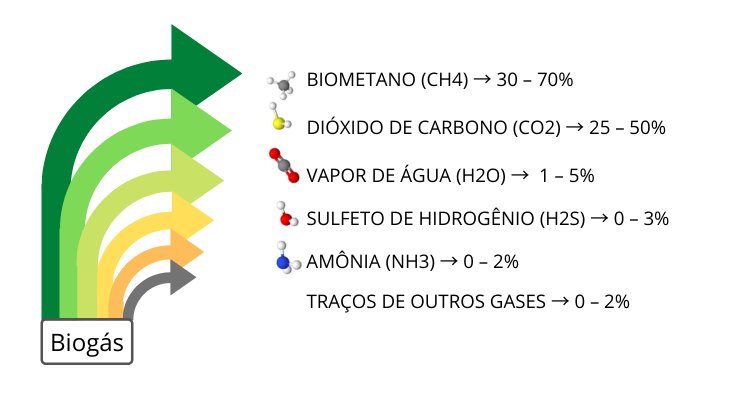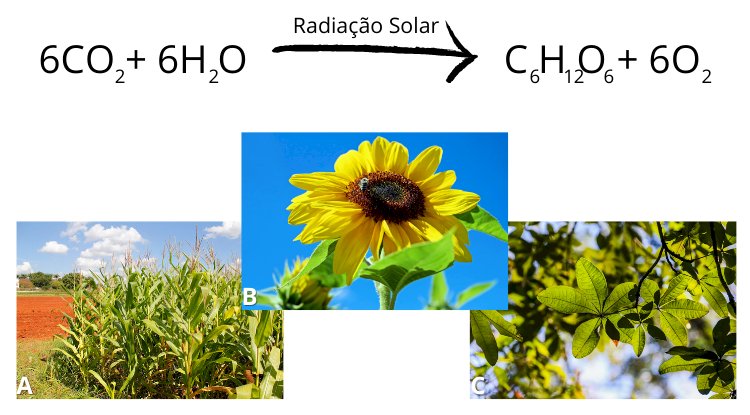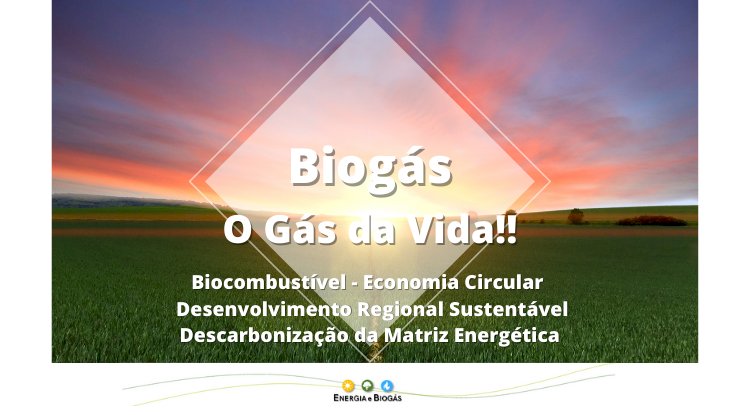Biogas
What is Biogas, Biomethane and Digestate?
1) What is Biogas?
Biogas is the mixture of all gases produced during the decomposition of organic waste. The decomposition of organic waste occurs in enclosed environments, such as areas with limited air exchange or in waterlogged environments where the submerged waste is isolated from the atmosphere, characterized as anaerobic environments (places lacking free atmospheric oxygen). Under these conditions, anaerobic microorganisms develop and consume the organic waste, producing biogas. Biogas is a blend of several gases: methane (CH4), carbon dioxide (CO2), water vapor (H2O), hydrogen sulfide (H2S), ammonia (NH3), and other gases that appear in proportions less than 1%.

The composition of biogas can vary widely and depends directly on the type of organic waste (raw material for biogas production or simply substrate) and the characteristics of the anaerobic biodigestion process. Among all the gases present in biogas, the only combustible gas is methane. The other gases present in biogas are impurities that can cause corrosion and wear in pipelines, engines, and other equipment.
They also contribute to reducing the calorific value of the biogas. In certain equipment, burning raw biogas can cause financial losses by reducing its lifespan, compromising the investment made in biogas production. Therefore, depending on the final use of biogas, it is very important to evaluate what type of cleaning and purification process will be necessary.
2) To what purpose does biogas serve?
Biogas is a gaseous fuel that can be used directly for various purposes. As a final use, it can be employed for space heating, grain drying, cooking, lighting, burning in boilers, or in direct-drive engines that operate with raw biogas.
Some uses of biogas require a cleaning process, mainly to remove moisture (water vapor – H2O), sulfur (hydrogen sulfide – H2S), and ammonia (NH3). This gas cleaning is essential when the final use involves burning in turbines, cogeneration engines, or as vehicle fuel.
In addition to gas cleaning, there is a purification process aimed at removing carbon dioxide (CO2) and other unwanted elements, thus increasing the methane concentration in biogas to above 90%. The purpose of purification is to raise the methane concentration in biogas, increasing its calorific value and making it equivalent to natural gas (fossil).
To differentiate methane obtained from biogas (renewable energy), we adopt the term "biomethane." Unlike natural gas, which is primarily composed of fossil methane, just like petroleum.
Both biomethane and natural gas have the same molecule type: methane (CH4).
The purification process makes biomethane equivalent to natural gas (fossil), allowing biomethane to have the same final uses as natural gas, such as industrial use, either in compressed biomethane (BioCNG), liquefied biomethane (BioLNG), or as vehicle fuel (biomethane vehicle - BioVNG).
Therefore, biomethane is a renewable gaseous biofuel interchangeable with natural gas, capable of being injected into the distribution network and having the same final uses as natural gas.
Attention: Biomethane and natural gas (fossil) are primarily composed of methane gas (CH4), unlike liquefied petroleum gas (LPG) used in cooking cylinders, which is mostly composed of butane gas (C4H10).
3) Why is biogas considered a renewable energy?
It all starts with plants and solar energy
Solar Energy → Biomass → Biogas
A transformation process from sunlight to biofuel production.
Plants perform photosynthesis using carbon dioxide, water, and solar energy to produce oxygen and glucose.

Figure 2 - Photosynthesis
Source: a) Corn plantation at ESALQ. Photo: Marcos Santos, USP Image Bank. b) Sunflower, PIXNIO; c) Trees and Leaves. Photo: Cecília Bastos, USP Image Bank.
In this process, carbon is removed from the atmosphere and fixed in plants as biomass (fruits, woods, vegetable oils, grains and seeds, straws, among other forms of sugars, starch, cellulose, etc.).
Photosynthesis is a process of converting solar energy into bioenergy. If at the beginning of this process we have photosynthesis generating biomass (all organic matter of plant or animal origin with potential for bioenergy production through anaerobic biodigestion), at the end of the cycle, the "lifespan" of plant and animal residues results in the decomposition of organic matter.
During decomposition, or simply decay, nature recycles nutrients in a process of transforming organic matter into minerals. Aerobic and anaerobic microorganisms act in this process, breaking down the structure of organic residues and releasing various elements that become nutrients for plants, thus making the carbon and nutrient cycles available again for other plants to perform photosynthesis.
The carbon emissions resulting from biogas combustion have a neutral balance in the atmosphere since they are part of the carbon cycle. Unlike burning fossil fuels, extracted from underground reserves, which release new carbon into the atmosphere when burned. The use of fossil fuels contributes to saturating the atmosphere with more carbon dioxide. This newly released carbon was previously stored in underground reservoirs.
The use of biogas can prevent organic waste from emitting methane directly into the atmosphere and simultaneously contribute to reducing the use of fossil fuels, thereby reducing the emission of fossil carbon into the atmosphere.
4) Examples of spontaneous biogas production
Have you heard of swamp gas or landfill gas?
An example of spontaneous biogas production in nature is the decay of materials in swamps, sludge in marshes mixed with vegetation, trees, and other submerged plant residues in dams or flooded areas, and even organic sediment in rice paddies can produce biogas. In other words, biogas is generated in the natural process of anaerobic decomposition of waste in environments without free atmospheric oxygen. Good examples of places where biogas production occurs spontaneously include cattle, poultry, and pig manure pits, as well as landfills and sewage sludge.
5) How is biogas produced for commercial use?
For commercial use of biogas, on a medium or large scale, there is a need for the development of large biodigesters (anaerobic reactors).
A complete plant for biogas production consists of different equipment distributed across various process units: substrate (biomass) receiving and storage unit; feeding unit; anaerobic reactors; digestate polishing and storage tanks; biogas gasometer; biogas cleaning and purification systems; generator set; biomethane storage; substrate analysis laboratories, inoculum analysis, biogas analysis, and process control center.

Figure 3 - Schematic representation of a biogas production plant
Source: Thzorro77, CC BY-SA 3.0, Wikimedia Commons.
The definition of the type of anaerobic reactor is directly related to the type of available substrate and the process model that will be used. There is no reactor that is inherently better or worse than another; rather, the goal is to define the most suitable reactor to operate within specific process parameters for a given installation, operation, and maintenance cost.
The decision to choose the type of anaerobic reactor and process model for a biogas production plant depends directly on a thorough analysis of technical and economic feasibility. This modeling is essential to determine the attractiveness of the investment.
6) What are the benefits of using biogas?
a. Environmental Benefits
The anaerobic digestion of organic waste enables proper disposal, stabilizing substrates that could otherwise impact the environment by contaminating soil, polluting water resources, and the atmosphere.
Organic waste, when turned into biomethane, contributes to improving the quality of life for populations in areas where activities have pollution potential due to excessive organic load. By preventing organic waste from rotting in inappropriate locations, it indirectly preserves public health from various vectors.
The decomposition of waste, without energy recovery, not only represents energy wastage but is also a contributing factor to global warming. Carbon emissions, whether in the form of carbon dioxide or methane, disrupt climatic factors. Currently, we observe changes in rainfall patterns affecting agriculture, electricity production, and costs (operation of the hydrothermal power system - dispatches from hydroelectric and thermal power plants), as well as impacting overall climate dynamics, resulting in extreme events that lead to economic losses and also loss of life (due to hurricanes, landslides caused by excessive rainfall, droughts, heavy snowfalls, among others).
b. Energy Production
The use of biogas enables direct substitution of other energy sources. It contributes to the energy self-sufficiency of the investor. It is a biofuel with great versatility in final use and is not directly exposed to currency fluctuations or changes in the price of oil barrels.
Generating energy with biogas minimizes exposure to climate-related risks, such as droughts affecting water reservoir levels. It is not affected by intermittency as wind and solar energy sources are.
In electricity generation, biogas is a dispatchable source with low storage costs compared to energy storage systems with lead-acid, nickel-cadmium, or lithium-ion batteries. Life Cycle Assessment (LCA) shows that biogas is extremely advantageous and competitive also in the storage segment.
c. Digestate and its Potential Use as Biofertilizer
The digestate obtained at the end of the anaerobic digestion process is a nutrient-rich effluent. When derived from agricultural residues, it can be used as a biofertilizer, provided it complies with legislation allowing its use as fertilizer. Biogas production can directly contribute to reducing agricultural production costs by reducing the need to purchase chemical fertilizers. Indirectly, this substitution (commercial fertilizers with biofertilizer) also contributes to greenhouse gas reduction, either through emissions avoided during fertilizer production or emissions avoided in logistics from the fertilizer factory to the rural property where it will be applied.
7) Final Considerations
Biogas is a renewable biofuel. Its production represents much more than just energy generation. Biogas represents a broad and complex concept; it is a vector for local development with potential national impact. It is a strategic link to enable the circular economy, providing nutrient recycling in many sectors. The use of biogas is an important step towards decarbonizing the energy matrix, enabling a reduction in dependence on fossil fuels.
Biogas is the path to an energy transition and can be the gateway to an energy matrix based on hydrogen, thus consolidating the transition from liquid fuels to gaseous fuels, which are less polluting and more efficient.
Para explorar outros conceitos, acesse o nosso Glossário.
Também aproveite para conferir Biometano, a energia que vem do campo.
Obrigado e boa leitura!

Referências bibliográficas consultadas
-
- AHRING, Birgitte K. et al. Biomethanation I. Springer, 2003.
- BERNS, B. A.; SCHNICKE, H. P.; BOMBONATTI, P. Anteprojeto de uma usina de pesquisa e capacitação em biogás / Probiogás; organizadores, Ministério das Cidades, Deutsche Gesellschaft für Internationale Zusammenarbeit GmbH (GIZ). Brasilia-DF: Ministério das Cidades. 160p, 2015. ISBN 978-85-7958-053-6
- BLEY JUNIOR, Cícero et al. Agroenergia da Biomassa Residual: perspectivas energéticas, socioeconômicas e ambientais. Foz do Iguaçu: Itaipu Binacional, 2009.
- BLEY JUNIOR, Cícero. Biogás: a energia invisível. São Paulo: Ed. Abril, 2014.
- CHERNICHARO, Carlos Augusto de Lemos. Reatores Anaeróbios – Princípios do tratamento biológico de águas residuárias. Belo Horizonte: Departamento de Engenharia Sanitária e Ambiental, Universidade Federal de Minas Gerais, v. 5, 2 Ed., p. 379, 2007.
- DEUBLEIN, Dieter; STEINHAUSER, Angelika. Biogas from waste and renewable resources: an introduction. John Wiley & Sons, 2011.
- HEFNER III, Robert A. The age of energy gases. International Journal of Hydrogen Energy, v. 27, n. 1, p. 1-9, 2002. DOI: 10.1016/S0360-3199(01)00079-9
- JENDE, Oliver. et al. Tecnologias de digestão anaeróbia com relevância para o Brasil: substratos, digestores e uso de biogás / Probiogás; organizadores, Ministério das Cidades, Deutsche Gesellschaft für Internationale Zusammenarbeit GmbH (GIZ). Brasília-DF: Ministério das Cidades. 83p, 2015. ISBN: 978-85-7958-039-0
- KUNZ, Airton; STEINMETZ, Ricardo Luis Radis; DO AMARAL, André Cestonaro. Fundamentos da digestão anaeróbia, purificação do biogás, uso e tratamento do digestato. Embrapa Suínos e Aves-Livro científico (ALICE), 2019.
- LUCAS JUNIOR, J.; SOUZA, C. F. ; LOPES, J. D. S. . Manual de construção e operação de biodigestores. 1. ed. Viçosa: CPT – Centro de Produções Técnicas, 2003. v. 1. 40p .
- WELLINGER, Arthur; MURPHY, Jerry D.; BAXTER, David (Ed.). The biogas handbook: science, production and applications. Elsevier, 2013.
Heleno Quevedo de Lima
Engenheiro, mestre e doutor em Energia. Pesquisador, especialista em biogás, entusiasta no desenvolvimento e consolidação do mercado de biogás/biometano. Atua como consultor de projetos e contribui para disseminação de conteúdo, notícias e conhecimento na área de biogás e energia solar.
Autor: Heleno Quevedo de Lima
Publicado em: 15 de dezembro de 2020.
Este conteúdo é de autoria do Portal Energia e Biogás e está licenciado via Creative Commons (CC-BY-NC-ND) para que possa ser republicado gratuitamente e de forma simples por outros veículos digitais ou impressos. O Portal Energia e Biogás deve ser creditado como a fonte do conteúdo que está sendo republicado e o nome do autor deve ser atribuído.

Apenas o conteúdo desta página está licenciado via Creative Commons - Atribuição-NãoComercial-SemDerivações 4.0 Internacional.